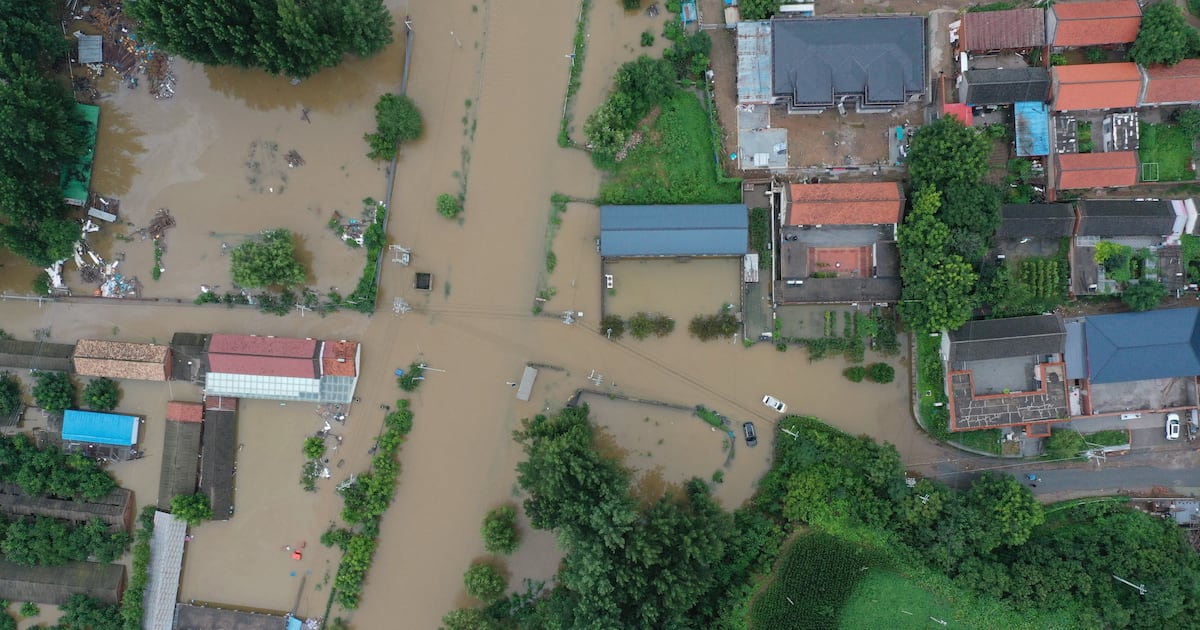World
Extreme Rainfall in Beijing Claims 30 Lives, Disrupts City

Severe rainfall in Beijing has resulted in at least 30 fatalities as the city experienced an unprecedented downpour, equivalent to an entire year’s worth of rain in just a few days. The torrential weather has overburdened the city’s disaster management systems, with experts labeling Beijing as a “rain trap.” The Chinese capital faced significant flooding, particularly in the mountainous regions north of the city, with 28 deaths reported in the Miyun District and two in Yanqing, according to the official Xinhua news agency.
Heavy rain began on July 5, 2023, and escalated dramatically by July 10, leading to a staggering 543.4 mm of rainfall recorded in northern districts. This amount is notably close to the city’s typical annual average of 600 mm. “The cumulative amount of precipitation has been extremely high, reaching 80–90 percent of the annual total in just a few days in some areas,” commented Xuebin Zhang, CEO of the Pacific Climate Impacts Consortium and a researcher at the University of Victoria. Dr. Zhang highlighted that very few systems are equipped to handle such intense rainfall within a short time frame.
The city’s geography has compounded the issue. The surrounding mountains trap moist air, which rises and enhances precipitation levels. Recent years have seen the typically dry northern regions of China face record rainfall, with some scientists attributing this shift to ongoing climate change. In summer 2023, a similar weather pattern led to at least 33 deaths in Beijing due to flooding.
As the extreme weather conditions persisted, Xi Jinping, President of China, acknowledged the “heavy casualties and property losses” across Beijing and neighboring provinces including Hebei, Jilin, and Shandong. He called for “all-out” search and rescue operations. Reports indicate that over 80,000 residents of Beijing were relocated to safer areas as roads and communication infrastructure suffered significant damage, with power outages affecting 136 villages.
The most intense rainfall struck on July 8, particularly in Beijing’s Huairou District, which recorded 95.3 mm of rain within a single hour. In Miyun, some individuals were trapped in an elderly care center as water levels rose perilously close to the roof. Emergency services responded swiftly, rescuing 48 people from the facility.
Public facilities such as parks, libraries, and museums, including the esteemed Palace Museum at the Forbidden City, closed in response to the flooding. Transportation services faced major disruptions; train and bus operations in suburban areas and along waterways were suspended, and hundreds of flights at Beijing’s airports were cancelled or delayed.
The impact of the rain was felt beyond Beijing, affecting neighboring areas such as Tianjin and regions in Hebei, part of the expansive Hai River basin. A landslide in Hebei resulted in the deaths of four individuals, with eight more reported missing as six months’ worth of rain fell over the weekend.
As authorities continue to assess the damage and coordinate relief efforts, the situation remains critical in the affected regions. The combination of extreme weather events and the challenges posed by urban infrastructure highlights the growing need for effective disaster preparedness in the face of climate change.
-

 Top Stories3 months ago
Top Stories3 months agoTributes Surge for 9-Year-Old Leon Briody After Cancer Battle
-

 Entertainment4 months ago
Entertainment4 months agoAimee Osbourne Joins Family for Emotional Tribute to Ozzy
-

 Politics4 months ago
Politics4 months agoDanny Healy-Rae Considers Complaint After Altercation with Garda
-

 Top Stories4 months ago
Top Stories4 months agoIreland Enjoys Summer Heat as Hurricane Erin Approaches Atlantic
-

 World5 months ago
World5 months agoHawaii Commemorates 80 Years Since Hiroshima Bombing with Ceremony
-

 Top Stories3 months ago
Top Stories3 months agoNewcastle West Woman Patricia Foley Found Safe After Urgent Search
-

 Top Stories5 months ago
Top Stories5 months agoFianna Fáil TDs Urgently Consider Maire Geoghegan-Quinn for Presidency
-

 World5 months ago
World5 months agoCouple Convicted of Murdering Two-Year-Old Grandson in Wales
-

 World5 months ago
World5 months agoGaza Aid Distribution Tragedy: 20 Killed Amid Ongoing Violence
-

 World5 months ago
World5 months agoAristocrat Constance Marten and Partner Convicted of Infant Murder
-

 Top Stories4 months ago
Top Stories4 months agoClimbing Errigal: A Must-Do Summer Adventure in Donegal
-

 Top Stories4 months ago
Top Stories4 months agoHike Donegal’s Errigal Mountain NOW for Unforgettable Summer Views









